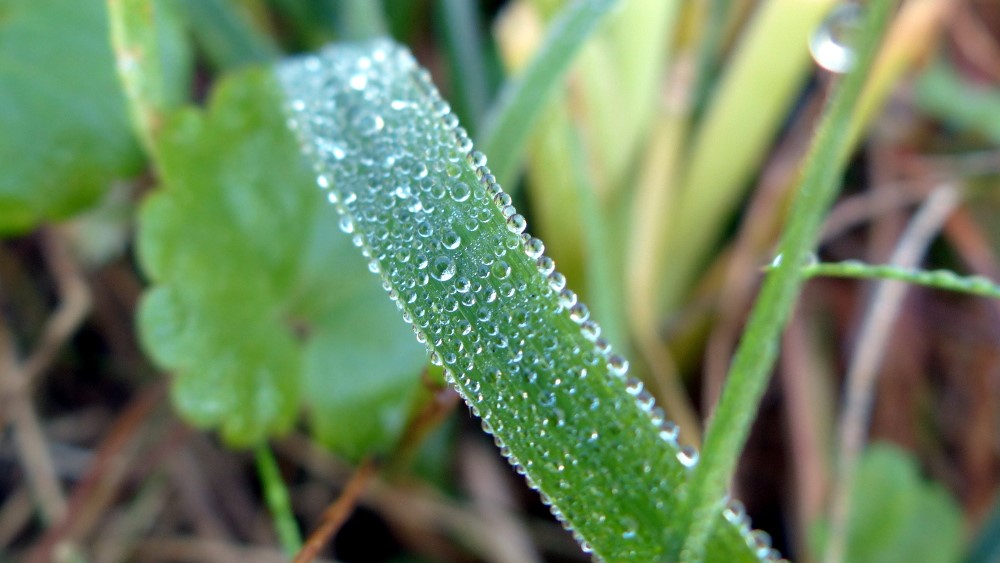IFDewS
The importance of dew was already recognised at the end of the 18th century. Scientists who tried to quantify dew yields in relation to rainfall estimated that dew contributed with 16% to the hydrological budget of England and Wales. Although with the progress in science we know and understand that such high dew yield estimates are unrealistic, we are quite certain that dew and fog have an effect on plant growth and how plants can cope with dry periods with no or low rainfall.

In our SNF funded project we plan to investigate, how dew and fog affect the growth of typical grassland plant species in Switzerland. Is it directly via dew and fog water increasing the plant cell water and thus reducing potential drought stress? Or is it rather indirect in a way that dew or fog droplets collected by the plants during the night cool the plant leaf surface in the first morning hours after sunrise, when the water evaporates and keeps leaves at low temperatures, which in turn benefits photosynthesis?
In detail, a small network collocated with existing long-term ecosystem research sites from ETH Zürich and WSL Birmensdorf at elevations from the Swiss Plateau up to an alpine pasture will be established to measure the frequency of fog and dew, and to quantify the water gains on grass swards under such conditions. Using stable isotopes in water we will then investigate the pathways from dew and fog water to plant water in order to quantify the share of dew and fog water that directly affects plant leaf water. Once we have gained the necessary process understanding, we will be able to hypothesize how the relevance of dew and fog will change with climate change, namely under summer conditions with longer and warmer dry spells or drought periods.
Publications
2023
Li Y, Eugster W, Riedl A, Westerhuis S, Buchmann N, Scholder-Aemisegger F (2023) Identifying key stages of radiation fog evolution using water vapor isotopes. Agricultural and Forest Meteorology 334: 109430, doi: external page 10.1016/j.agrformet.2023.109430
Li Y, Eugster W, Riedl A, Lehmann MM, Aemisegger F, Buchmann N (2023) Dew benefits on alpine grasslands are cancelled out by combined heatwave and drought stress. Frontiers in Plant Science 14: 1136037, doi: external page 10.3389/fpls.2023.1136037
Li Y, Riedl A, Eugster W, Buchmann N, Cernusak LA, Lehmann MM, Werner RA, Aemisegger F (2023) The role of radiative cooling and leaf wetting in air–leaf water exchange during dew and radiation fog events in a temperate grassland. Agricultural and Forest Meteorology 328: 109256, doi: external page 10.1016/j.agrformet.2022.109256
2022
Riedl A, Li Y, Eugster J, Buchmann N, Eugster W (2022) Technical note: High accuracy weighing micro-lysimeter system for long-term measurements of non-rainfall water inputs to grasslands. Hydrology and Earth System Sciences 26: 91-116, doi: external page 10.5194/hess-26-91-2022
2021
Li Y, Aemisegger F, Riedl A, Buchmann N, Eugster W (2021) The role of dew and radiation fog inputs in the local water cycling of a temperate grassland during dry spells in Central Europe. Hydrology and Earth System Sciences 25: 2617-2648, doi: external page 10.5194/hess-25-2617-2021
Riedl A, Li Y, Buchmann N, Eugster W (2021) Technical note: High accuracy weighing micro-lysimeter system for long-term measurements of non-rainfall water inputs to grasslands. Hydrology and Earth System Sciences Discussions, external page 10.5194/hess-2021-317 [preprint]
2020
Li Y, Aemisegger F, Riedl A, Buchmann N, Eugster W (2020) The role of dew and radiation fog inputs in the local water cycling of a temperate grassland in Central Europe. Hydrology and Earth System Sciences Discussions, doi: external page 10.5194/hess-2020-493
2018
Klemm O, Eugster W, Scholl M, Gonçalves F L T, Katata G, Lin N-H (2018) Preface to the AAQR special issue "Fog, fog collection and dew“. Aerosol and Air Quality Research 18: I-II doi: external page 10.4209/aaqr.2018.01.FOG